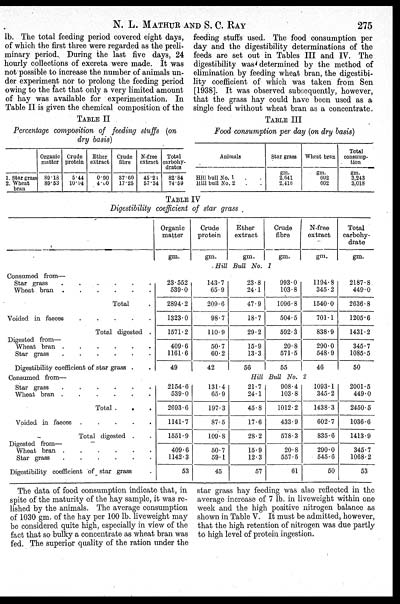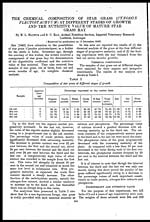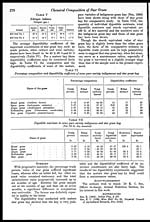Medicine - Veterinary > Veterinary colleges and laboratories > Indian journal of veterinary science and animal husbandry > Volume 13, 1943 > Original articles > Chemical composition of star grass (Cynodon plectostachyum) at different stages of growth and the nutritive value of mature star grass hay
(319) Page 275
Download files
Individual page:
Thumbnail gallery: Grid view | List view

N. L. MATHUR AND S. C. RAY 275
lb. The total feeding period covered eight days,
of which the first three were regarded as the preli-
minary period. During the last five days, 24
hourly collections of excreta were made. It was
not possible to increase the number of animals un-
der experiment nor to prolong the feeding period
owing to the fact that only a very limited amount
of hay was available for experimentation. In
Table II is given the chemical composition of the
feeding stuffs used. The food consumption per
day and the digestibility determinations of the
feeds are set out in Tables III and IV. The
digestibility was determined by the method of
elimination by feeding wheat bran, the digestibi-
lity coefficient of which was taken from Sen
[1938]. It was observed subsequently, however,
that the grass hay could have been used as a
single feed without wheat bran as a concentrate.
TABLE II
Percentage composition of feeding stuffs (on
dry basis)
|
Organic |
Crude |
Ether |
Crude |
N-free |
Total |
|
|
1. Star grass |
89.18 |
5.44 |
0.90 |
37.60 |
45.21 |
82.84 |
|
2. Wheat |
89.53 |
10.94 |
4.60 |
17.25 |
57.34 |
74.59 |
TABLE III
Food consumption per day (on dry basis)
|
Animals |
Star grass |
Wheat bran |
Total |
|
gm. |
gm. |
gm. |
|
|
Hill bull No. 1 |
2,641 |
602 |
3,243 |
|
Hill bull No. 2 |
2,416 |
602 |
3,018 |
TABLE IV
Digestibility coefficient of star grass
|
Organic |
Crude |
Ether |
Crude |
N-free |
Total |
|
|
gm. |
gm. |
gm. |
gm. |
gm. |
gm. |
|
|
Hill Bull No. 1 |
||||||
|
Consumed from— |
||||||
|
Star grass . . . . . . |
23.552 |
143.7 |
23.8 |
993.0 |
1194.8 |
2187.8. |
|
Wheat bran . . . . . . |
539.0 |
65.9 |
24.1 |
103.8 |
345.2 |
449.0 |
|
Total . |
2894.2 |
209.6 |
47.9 |
1096.8 |
1540.0 |
2636.8 |
|
Voided in faeces . . . . . |
1323.0 |
98.7 |
18.7 |
504.5 |
701.1 |
1205.6 |
|
Total digested . |
1571.2 |
110.9 |
29.2 |
592.3 |
838.9 |
1431.2 |
|
Digested from— |
||||||
|
Wheat bran . . . . . . |
409.6 |
50.7 |
15.9 |
20.8 |
290.0 |
345.7 |
|
Star grass . . . . . . |
1161.6 |
60.2 |
13.3 |
571.5 |
548.9 |
1085.5 |
|
Digestibility coefficient of star grass . . |
49 |
42 |
56 |
55 |
46 |
50 |
|
Hill Bull No. 2 |
||||||
|
Consumed from— |
||||||
|
Star grass . . . . . . |
2154.6 |
131.4 |
21.7 |
908.4 |
1093.1 |
2001.5 |
|
Wheat bran . . . . . . |
539.0 |
65.9 |
24.1 |
103.8 |
345.2 |
449.0 |
|
Total . . . |
2693.6 |
197.3 |
45.8 |
1012.2 |
1438.3 |
2450.5 |
|
Voided in faeces . . . . . |
1141.7 |
87.5 |
17.6 |
433.9 |
602.7 |
1036.6 |
|
Total digested . . |
1551.9 |
109.8 |
28.2 |
578.3 |
835.6 |
1413.9 |
|
Digested from— |
||||||
|
Wheat bran . . . . . . |
409.6 |
50.7 |
15.9 |
20.8 |
290.0 |
345.7 |
|
Star grass . . . . . . |
1142.3 |
59.1 |
12.3 |
557.5 |
545.6 |
1068.2 |
|
Digestibility coefficient of star grass . |
53 |
45 |
57 |
61 |
50 |
53 |
The data of food consumption indicate that, in
spite of the maturity of the hay sample, it was re-
lished by the animals. The average consumption
of 1030 gm. of the hay per 100 lb. liveweight may
be considered quite high, especially in view of the
fact that so bulky a concentrate as wheat bran was
fed. The superior quality of the ration under the
star grass hay feeding was also reflected in the
average increase of 7 lb. in liveweight within one
week and the high positive nitrogen balance as
shown in Table V. It must be admitted, however,
that the high retention of nitrogen was due partly
to high level of protein ingestion.
Set display mode to: Large image | Zoom image | Transcription
Images and transcriptions on this page, including medium image downloads, may be used under the Creative Commons Attribution 4.0 International Licence unless otherwise stated. ![]()
| Permanent URL | https://digital.nls.uk/75473483 |
|---|
| Description | Covers articles from 1943. |
|---|




